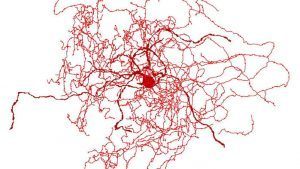Kelly Servick in Science:
 In a mysterious addition to the brain’s family of cells, researchers have discovered a new kind of neuron—a dense, bushy bundle (above) that is present in people but seems to be missing in mice. These “rosehip neurons,” were found in the uppermost layer of the cortex, which is home to many different types of neurons that inhibit the activity of other neurons. Scientists spotted the neurons in slices of human brain tissue as part of a larger effort to inventory human brain cells by combining microscopic study of brain anatomy and the genetic analysis of individual cells. The cells were small and compact, with a dense, bushy shape. At the points along their projections where they transmit signals to other cells—called axonal boutons—they had unusually large, bulbous structures, which inspired their name.
In a mysterious addition to the brain’s family of cells, researchers have discovered a new kind of neuron—a dense, bushy bundle (above) that is present in people but seems to be missing in mice. These “rosehip neurons,” were found in the uppermost layer of the cortex, which is home to many different types of neurons that inhibit the activity of other neurons. Scientists spotted the neurons in slices of human brain tissue as part of a larger effort to inventory human brain cells by combining microscopic study of brain anatomy and the genetic analysis of individual cells. The cells were small and compact, with a dense, bushy shape. At the points along their projections where they transmit signals to other cells—called axonal boutons—they had unusually large, bulbous structures, which inspired their name.
To precisely classify these cells, the scientists then analyzed their gene expression. That’s when they realized that the set of genes expressed in these inhibitory rosehip neurons doesn’t closely match any previously identified cell in the mouse, suggesting they have no analog in the rodent often used as a model for humans, the authors report today in Nature Neuroscience. The discovery also raises the question of whether these neurons are key to certain brain functions that separate us from mice.
More here.
